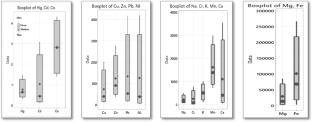The assessments of heavy metal soil pollution in Kosovo are deficient. Considering that Kosovo is characterized by complex geological settings and high mining activity, it is important to assess the risk of heavy metal soil pollution. The research aims to evaluate the level and spatial distribution of some heavy metals and biogenic elements in soil samples throughout the whole territory of the country. The surface soil samples were collected at 0–25 cm depth from twenty-four sampling sites evenly distributed in the study area. Each site comprised five to ten sub-samples within a 50 × 50 m expanse. The concentration of elements (Cd, Pb, Co, Cu, Mn, and Ni) was determined by graphite-furnace atomic absorption spectroscopy (GFAAS). Atomic absorption spectroscopy (AAS) and atomic emission spectroscopy (AES) were used to determine the levels of Ca, Mg, Na, K, Zn, and Fe, while cold vapor atomic absorption spectroscopy (CVAAS) was used for the determination of Hg. For the processing of experimental data, statistical analyses (descriptive statistics, correlation analysis, and linear regression) were applied, as were cluster and factor analyses. The concentrations of heavy metals and biogenic elements, based on their average values in the soil samples, exhibited the following trend: Fe > Mg > Ca > Mn > K > Cr > Na > Ni > Pb > Zn > Cu > Co > Cd > Hg. In specific sampling locations, the concentrations of Pb, Cd, Cu, and Ni surpassed the maximum thresholds set by the EU directive. Long-term emission inputs from the mining industry, coal-fired power sources, and areas with heavy vehicular traffic are the main sources of these elements. The outcomes of this investigation provide precise information regarding potential sources of metal pollution in contaminated areas, thereby serving as a basis for future research endeavors and enabling relevant institutions to implement strategies aimed at reducing this form of pollution.



